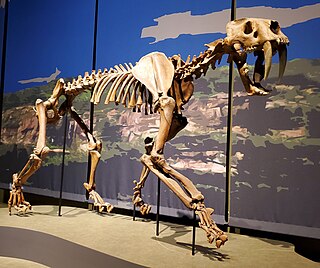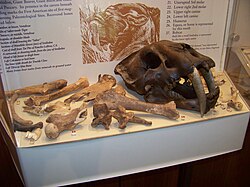
The Nashville Predators are a professional ice hockey team based in Nashville, Tennessee. The Predators compete in the National Hockey League (NHL) as a member of the Central Division in the Western Conference, and have played their home games at Bridgestone Arena since 1998. Their television broadcasting rights are held by Bally Sports South, and the Nashville Predators Radio Network flagship station is WPRT-FM. The Predators are currently affiliated with two minor league teams: the Milwaukee Admirals of the American Hockey League (AHL), and the Atlanta Gladiators of the ECHL.

Smilodon is a genus of felids belonging to the extinct subfamily Machairodontinae. It is one of the best known saber-toothed predators and prehistoric mammals. Although commonly known as the saber-toothed tiger, it was not closely related to the tiger or other modern cats. Smilodon lived in the Americas during the Pleistocene epoch. The genus was named in 1842 based on fossils from Brazil; the generic name means "scalpel" or "two-edged knife" combined with "tooth". Three species are recognized today: S. gracilis, S. fatalis, and S. populator. The two latter species were probably descended from S. gracilis, which itself probably evolved from Megantereon. The hundreds of specimens obtained from the La Brea Tar Pits in Los Angeles constitute the largest collection of Smilodon fossils.

Homotherium is an extinct genus of machairodontine scimitar-toothed cat that inhabited North America, South America, Eurasia, and Africa during the Pliocene and Pleistocene epochs from around 4 million to 12,000 years ago. In comparison to Smilodon, the canines of Homotherium were shorter, and it was probably adapted to running down rather than ambushing prey.

Peter Wilhelm Lund was a Danish Brazilian paleontologist, zoologist, and archeologist. He spent most of his life working and living in Brazil. He is considered the father of Brazilian paleontology as well as archaeology.

A saber-tooth is any member of various extinct groups of predatory therapsids, predominantly carnivoran mammals, that are characterized by long, curved saber-shaped canine teeth which protruded from the mouth when closed. Saber-toothed mammals have been found almost worldwide from the Eocene epoch to the end of the Pleistocene epoch.

Panthera atrox, better known as the American lion, also called the North American lion, or American cave lion, is an extinct pantherine cat. Panthera atrox lived in North America during the Pleistocene epoch, from around 340,000 to 12,800 years ago. The species was initially described by American paleontologist Joseph Leidy in 1853 based on a fragmentary mandible (jawbone) from Mississippi; the species name ('atrox') means "savage" or "cruel". The status of the species is debated, with some mammalogists and paleontologists considering it a distinct species or a subspecies of Panthera leo, which contains living lions. However, novel genetic evidence has shown that it is instead a distinct species derived from the Eurasian cave or steppe lion, evolving after its geographic isolation in North America. Its fossils have been excavated from Alaska to Mexico. It was about 25% larger than the modern lion, making it one of the largest known felids.

Machairodontinae is an extinct subfamily of carnivoran mammals of the family Felidae. They were found in Asia, Africa, North America, South America, and Europe from the Miocene to the Pleistocene, living from about 16 million until about 10,000 years ago.

First American National Bank was a subsidiary of First American Corporation, a financial institution based in Nashville, Tennessee, that served the states of Tennessee, Kentucky, Georgia and Virginia. It was headquartered in the First American Center in downtown Nashville.

Robert Bruce Ferguson was an American country music songwriter and record producer who was instrumental in establishing Nashville, Tennessee as a center of country music. He was also a movie producer, and Choctaw Indian historian. Ferguson is best known for writing the bestselling songs "On the Wings of a Dove" and "The Carroll County Accident". The "Carroll County Accident" won the Country Music Association Song of the Year in 1969. In 1983 "Wings of a Dove" was featured in the movie Tender Mercies starring Robert Duvall. In 1987, Broadcast Music Incorporated (BMI) awarded Ferguson with the "million air" plays for the "Wings of a Dove."

Xenosmilus is an extinct genus of homotherin machairodontine that was discovered in Florida in 2001. It has one species, Xenosmilus hodsonae.

Megantereon was a genus of prehistoric machairodontine saber-toothed cat that lived in North America, Eurasia, and Africa. It is closely related to and possibly the ancestor of Smilodon.
Buhla is the name for a skeleton of a prehistoric (Paleo-Indian) woman found in a quarry near Buhl, Idaho, United States, in January 1989. The skeleton's age has been estimated by radiocarbon dating at 10,675 ± 95 BP, which confirms this as one of the oldest sets of human remains found in the Americas. The discovery was made by a quarry worker when he noticed what was found to be a thigh bone in the screen of a rock crusher. The nearly complete skeleton was subsequently unearthed nearby.

Cueva del Milodón Natural Monument is a Natural Monument located in the Chilean Patagonia, 24 km (15 mi) northwest of Puerto Natales and 270 km (168 mi) north of Punta Arenas.

Melbourne Bone Bed is a paleontological site located at Crane Creek in Melbourne, in the U.S. state of Florida. This site contains fossils from the Late Pleistocene period 20,000 to 10,000 years before present. The fossils include extinct animals such as varieties of camels, dire wolves, Florida cave bears, giant armadillos, giant beavers, giant bison, giant ground sloths, mammoths, mastodons, saber-toothed cats and tapirs.
The Port Kennedy Bone Cave is a limestone cave in the Port Kennedy section of Valley Forge National Historical Park, Pennsylvania, USA. The Bone Cave "contained one of the most important middle Pleistocene fossil deposits in North America".

The First American Cave is an archaeological and palentological site in downtown Nashville, Davidson County, Tennessee. The site was initially recognized in 1971 during construction of the foundations for the First American National Bank building at 315 Deaderick Street, when workers noticed a collection of bones being unearthed within a pocket of dirt approximately 30 feet below ground surface. Excavations were halted and both the Vanderbilt University Department of Anthropology and the Southeastern Indian Antiquities Survey were notified of the find. It was subsequently determined that the bones included those of humans, as well as a number of animal species, including a saber-tooth cat. The dirt pocket from which the bones had been disinterred was in fact a filled in cave, most of which had been destroyed by construction. The Southeastern Indian Antiquities Survey was given permission to excavate within the remaining portion of the cave with the assistance of Vanderbilt University students.
The Coats–Hines–Litchy site is a paleontological site located in Williamson County, Tennessee, in the Southeastern United States. The site was formerly believed to be archaeological, and identified as one of only a very few locations in Eastern North America containing evidence of Paleoindian hunting of late Pleistocene proboscideans. Excavations at the site have yielded portions of four mastodon skeletons, including portions of one previously described as being in direct association with Paleoindian stone tools. The results of excavations have been published in Tennessee Conservationist, and the scholarly journals Current Research in the Pleistocene, Tennessee Archaeology, and Quaternary Science Reviews. The site was listed on the National Register of Historic Places on July 12, 2011.

The Wezmeh Cave is an archaeological site near Islamabad Gharb, western Iran, around 470 km (290 mi) southwest of the capital Tehran. The site was discovered in 1999 and excavated in 2001 by a team of Iranian archaeologists under the leadership of Dr. Kamyar Abdi. Wezmeh cave was re-excavated by a team under direction of Fereidoun Biglari in 2019.
The Conard Fissure is a geologic feature in Northern Arkansas where a deposit of Pleistocene fossils was discovered in 1903. Several specimens from saber-toothed cats were found there among other species.

Panthera balamoides is a species described as an extinct species of the big cat genus Panthera that is known from a single fossil found in a Late Pleistocene age cenote in the Yucatan Peninsula, Mexico. P. balamoides has only a single reported specimen, the distal end of a right humerus, that is notably of exceptional size for a felid. It was unearthed in 2012 from an underwater cave and described in 2019 by an international group of paleontologists from Mexico and Germany led by Sarah R. Stinnesbeck. However, several authors have since proposed that the fossil comes from an ursid, possibly the extinct Arctotherium, and not of felid affinities.


















